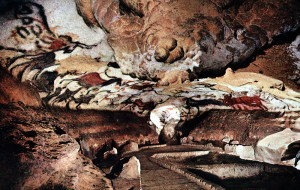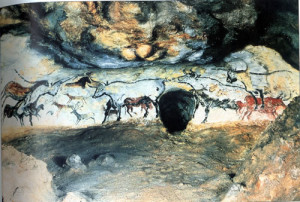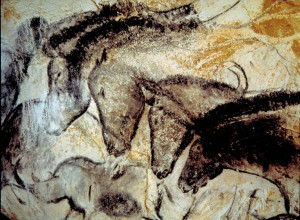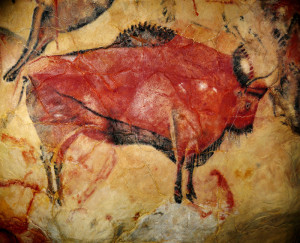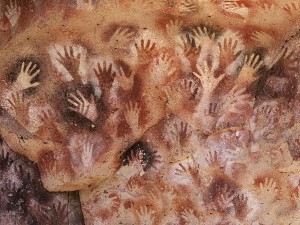An open letter to the person in the black Maxima that was driving in front of me this afternoon on our way home from the library: I noticed you had a couple of bumper stickers on the rear of your car. Now as far as bumper stickers go, yours were pretty basic inflammatory-generalizations-that-you-force-random-strangers-to-read-while-they’re-stuck-behind-you-in-rush-hour-traffic. Now among your plethora on political slogans, fiery non sequitur quotes, and declarations about the current socio-political climate, I noticed one of your numerous opinionated buzzwords was the phrase “Advertisements are the new cave art.”
Now I am not one to judge your opinion on the expansive and diverse world of advertising, nor am I to know the reason you decided to broadcast that particular statement to the world, but I was rather disturbed by your proclamation that advertising (which I assume you deem as idiotic based on the context of the other obviously anti-consumerist stickers you placed on the back of the car) is like cave art.
In this statement, you are obviously implying that advertising is lowbrow, ignorant, and uncultured, like prehistoric cavern drawings. Now I will not deny that advertising can be quite bawdy and often downright trashy, but I’d hardly equate it to the prehistoric art of our ancestors. I find that quite slanderous to say that the beauty and sophistication of Paleolithic artwork is stupid or simplistic.
But then again, I realize that many modern-day Americans are quite unaware of how awe-inspiring Paleolithic art is. I know before school started, I believed that all cave art was “primitive” little stick figures scrawled on walls by dumb cavemen, without meaning or style. But in this past month alone I have studied over 30,000 years of Art History with my fantastic art teacher Ms. McHugh and have been enlightened to the wonderful and evocative images that our ancestors created on the walls of caves so many millennia ago.
Take this example of Paleolithic (meaning “Old Stone Age”) art found in the Lascaux Caves in France. This is from the gorgeous “Hall of the Bulls”, a huge cavern that has an entire ceiling covered in absolutely fantastic paintings of horses, bison, bulls, aurochs (a prehistoric cow) and rhinoceroses all captured in breathtaking detail. Looking at pictures of the Lascaux Caves, you can practically hear the thunderous clattering of hooves on stone as the horses leap from wall to wall, their powerful dynamic movement expressed in bold oranges and earthy browns, forms outlined with rich black charcoal. The fur of the shaggy horses is expertly contrasted the smooth hides of bulls, who dance from one rock outcropping to another in a graceful balance of color and texture. These paintings are estimated to be over 17,000 years old! Some of the bulls are over 17 feet long and there are over 2,000 figures that grace the ancient walls. These wonderful images were created with only the light of torches, using the simplest of materials, burned sticks, natural pigments from berries, and minerals found in rocks to express their world.
Another exquisite collection of cave art is found in Altamira Cave in Spain. Here, beautiful red bison and spotted horses stand serenely on the expansive cave walls. When Altamira Cave was discovered in 1880, historians were in an uproar because no one had ever imagined that supposedly simple prehistoric man could have produced such breathtaking art. Some historians even accused Altamira’s discoverers of having forged the images. But science in the form of uranium-thorium dating proved that these glorious images had been painted over 30,000 years ago.
So yes, Ms. Black Maxima, you are not to blame for your mindset that prehistoric man was a simpleton. Even the greatest minds of the 19th century thought beautiful art was something our ancestors were incapable of. But it has been over 120 years since Altamira was discovered, and over 50 since Lascaux. Why then, as modern Americans, are we so unfamiliar to the fantastic art of our forefathers?
Do we think it is unimportant? Some silly doodles splatted onto walls of stone tens of thousands of years ago? Do we think that these paintings are not important to the history of mankind? Think about it, these people, simple hunter-gatherers who lived their short lives on the very edge of death in a frantic and never ending race for survival, took precious time out of their all-consuming fight for the right to live to draw these “silly” pictures on the walls. They infused their life, their soul, their very being into what they drew on those dark stone walls. Why did they do it? What is the use of drawing a picture of a bull when you must go out and slaughter one?
I believe that these people, these cavemen, who had no written language to pass down their stories, had to make their children’s children remember. They had to write their lives on stone and keep their stories and their way of life from being forgotten. These people, these human beings gave us a slice of their life, a tiny sliver of how they thought and what they valued. Their entire lives centered around the hunt and that is what they showed us, the magical beasts who gave them sustenance in a perilous world.
Why should we care, you might say? Well, all the people who painted those walls, who lived in those caves, and were buried in that ground are dead now and we cannot remember a single one of them. Even if we miraculously find their bones, we can never know who they were, what their personality was like or even their names. These paintings, these “primitive scrawlings”, are all we have left of them. These walls are the last legacy of the people who are our great to the millionth power grandfathers. We would not exist if they hadn’t existed so I think they deserve a little bit of respect.
In conclusion Ms. Maxima, if you equate advertising to cave art, then you are basically saying that Burger King peddling a Whopper Junior is the same as our forefathers’ final testament to the beauty and hardship of their lives. I guess the moral of the story is, don’t stick a questionable bumper sticker onto your car if it concerns art history because then you’ll get a thousand word rant from Maddie Kurtz.
